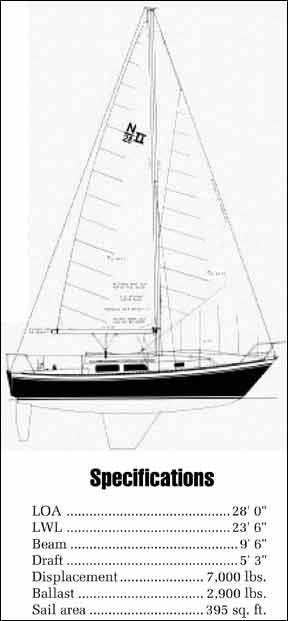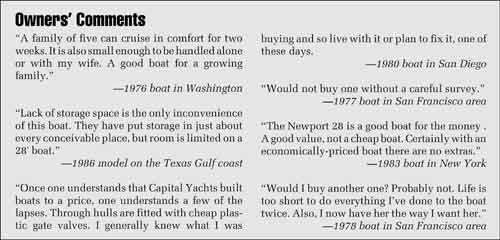The Newport 28 was one of the longer-lived small production cruising boats, having been in production from 1974 through 1987. Almost 1,000 of the C&C-designed boats were built by Capital Yachts of Harbor City, California.

There is a strong family resemblance between the Newport 28 and other C&C designs of the same period. In addition to the Newport 28, Capital built the Newport 41, another mid-1970s C&C design. The styling of both boats is characterized by the sweeping attractive sheerlines for which C&C is justifiably known.
As with any boat whose production run spanned more than a decade, many changes were made in the Newport 28, both outside and inside, over the years. The original scimitar-shaped keel and rudder gave way to more modern high aspect ratio appendages with 1983 models, increasing draft from 4′ 6″ to 5′ 2″. A shoal draft version drawing 4′ was optional, but
less popular than the deep-keel boat. Versions with the modern keel are designated Newport 28-II.
Sailing Performance
The Newport 28 has a tall, high aspect ratio masthead rig. The newer deep keel models are about six seconds per mile faster than the original version of the boat, which typically sails with a PHRF rating of 192. This is comparable to other cruiser-racers of the same size.
Despite a fairly high ballast/displacement ratio, owners report that the boat is tender. This is due in part to the fairly round midship section, and in part to the fact that few 28′ boats are really very stiff.
Racing in Newport 28s is quite keen in some areas, particularly on the West Coast, where there are large fleets that race both as one-designs and under PHRF. The boat is a competitive PHRF racer, and enough boats have been rated so that its handicap appears fair. This means you are likely to get a rating based on the boat’s performance, not on your own sailing ability.
Most owners report that the boat is very well balanced. This is typical of C&C designs, which usually have fairly small mainsails. With a large foretriangle and a small mainsail, it may be necessary to rake the mast aft slightly to give the boat a little weather helm. It’s far easier to add weather helm than to reduce it.
Construction
Make no mistake about it, the Newport 28 is a boat built to a price. A common complaint by owners is mediocre fitting of woodwork, leaking hull-to-deck joint, cockpit drains that are too small, plastic valves on through hull fittings, inadequate backing plates for hardware—in short, the entire litany of problems associated with boats built to be low in price.
One owner who races his boat hard noticed a large crack in the hull molding aft of the primary sheet winches, and discovered that he could see daylight through it. Apparently, the hull had been cracked in removing it from the mold, and the cracked patched over with auto body filler. This was on a new boat. The factory made good on that one.
Why would so many people buy a boat that apparently has a history of minor construction flaws and mediocre quality control?
The answer, according to owners, is that the basic styling, accommodations, and performance are better than other boats of the same size and type, making up for other shortcomings. When you buy a Chevrolet you know in advance that it isn’t going to be built like a Mercedes.
Interior
The interior is one factor that many owners report is a major influence in their decision to buy a Newport 28. With a waterline length of 23′ 6″, there’s a lot of interior for a 28′ boat.
Despite the fairly low freeboard and pronounced concave sheer, there is just over 6′ of headroom on centerline over the main cabin. The pronounced camber of the main cabintop keeps the deckhouse profile low, but at the expense of headroom, which diminishes very quickly away from the centerline. Fortunately, on a boat this small you’re almost always walking near the centerline.
There have been three basic interior arrangements over the years: galley along the starboard side of the main cabin, galley aft on the port side, and galley aft on the starboard side. On later models, only the two aft galley configurations were available. The galley aft on starboard side is the only layout that offers a stove with oven, due to the setup of the main cabin settees.
Unfortunately, this galley arangement required cutting away the starboard main bulkhead beneath the chainplates to make the starboard settee long enough for sleeping, which in our opinion is a structural compromise.

Since there are four other berths in the boat—two forward, the port settee, and a quarterberth—using the starboard settee as a berth isn’t necessary with anything less than a full crew. For family cruising, it is likely that at least one member of the crew would be short enough to use the starboard settee even without the foot extension.
Engine
Originally, the boat was equipped with the Atomic Four gasoline inboard, a standard engine in most auxiliaries until the proliferation of diesel power in the early 1980s. Diesel power was optional until the introduction of the 28-II model.
Some boats have Yanmar diesels, others Universal. It took the builder a while to decide which diesel engine to use, as owners report engines ranging in horsepower from 11 to 18. To most owners, there appears to be little difference in performance between diesel engines of various sizes. All of the Universal diesels should be adequate for the boat, and the Atomic Four is far more power than she needs.
Obviously, the diesel engine is a big plus when shopping for a used boat. Retrofitting a diesel on a gas-powered boat of this size is usually more expense than can be justified unless you’re planning to keep the boat for a long time.
Access to the engine for service varies from awful to good, depending on the model year. Fortunately, newer models have better access from the interior as well as a flush hatch in the cockpit sole directly over the engine.
Buying A Used Boat
Because so many owner complaints center on fairly mediocre construction detailing, a used boat should be carefully surveyed before purchase. Particular attention should be paid to structural details of the hull-to-deck joint, attachment of bulkheads, and mounting of deck hardware.
Obviously, a later model boat with a diesel engine is more desirable than an older boat with a gas engine. We would also consider the 28-II version with updated keel and rudder to be more desirable than the earlier design.
Because of the large number of Newport 28s built, at any given time there are a number of boats on the market. This means you should be able to find the combination of ingredients you’re looking for for in age, power plant, keel, and interior layouts—especially if you’re shopping on the West Coast.
It would be a good idea to look at all three interior arrangements before making a decision, although if you opt for a newer boat your choice will be between the two aft galley interiors.
Some of the boats have been seriously upgraded by owners, including such things as larger cockpit drains and higher quality hull hardware.
We would be wary about any boat that showed a lot of inexpert do-it-yourself characterisitics, such as caulking along the hull-to-deck joint, around the ports, or around the chainplates.
Although a tiller is standard, a fair number of boats have been equipped with wheel steering, either as an original option or as a retrofit.
The steering pedestal takes up far less room than the tiller, but it does require that the helmsman sit all the way in the back of the boat. While this arrangement keeps the cockpit less crowded for racing, it also puts all the helmsman’s weight at the aft end of the boat—not a good place for it.
In addition, the helmsman on a wheel-steered boat cannot reach either the mainsheet or the jib sheets, a serious shortcoming. He furthermore has trouble hiding from rain and spray under a companionway dodger.
Life for the helmsman on a wheel-steered Newport 28 will be a lonely one. Wheel steering, being hardly necessary on a boat this size, is hardly desirable on the Newport 28.
Conclusion
The Newport 28 is a good entry-level cruiser-racer for someone wanting a reasonable combination of accommodations and performance, as long as you’re not too persnickety about details. It would be a reasonable compromise for someone who likes more traditional appearance in a modern boat, but doesn’t have the money to spend for a higher-quality boat of the same size and type, such as a Sabre 28.






































